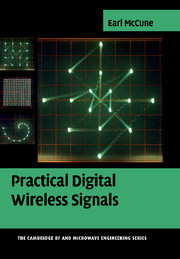Book contents
- Frontmatter
- Contents
- Preface
- Definitions and acronyms
- Terminology and notation
- 1 Keying, states, and block diagram construction
- 2 Common issues and signal characterization
- 3 Important details on results from Shannon, Nyquist, and others
- 4 Digital amplitude modulation (ASK)
- 5 Digital frequency modulation: FSK
- 6 Digital phase modulation: PSK
- 7 Combined digital modulations: QAM and OFDM
- 8 Spread spectrum
- 9 Wireless propagation and antenna fundamentals
- 10 Principles of coding
- 11 Multiple access techniques
- 12 Signal tradeoffs and system evolution
- Tutorial Appendices
- Index
- References
7 - Combined digital modulations: QAM and OFDM
Published online by Cambridge University Press: 04 August 2010
- Frontmatter
- Contents
- Preface
- Definitions and acronyms
- Terminology and notation
- 1 Keying, states, and block diagram construction
- 2 Common issues and signal characterization
- 3 Important details on results from Shannon, Nyquist, and others
- 4 Digital amplitude modulation (ASK)
- 5 Digital frequency modulation: FSK
- 6 Digital phase modulation: PSK
- 7 Combined digital modulations: QAM and OFDM
- 8 Spread spectrum
- 9 Wireless propagation and antenna fundamentals
- 10 Principles of coding
- 11 Multiple access techniques
- 12 Signal tradeoffs and system evolution
- Tutorial Appendices
- Index
- References
Summary
Signal types and characteristics
Until now, we have considered the three fundamental types of digital wireless modulation separately. Of course combinations are possible, and several combined modulations are widely used and very important. Three of the more significant combined digital modulations are discussed in this chapter.
Like everything else in this world, there is no “free lunch”. This means that a cost is associated with each additional feature or capability gained by adopting one of these modulation types. While it is impossible to exhaustively list the advantages and costs for each type of combined modulation discussed here, there are general characteristics which are introduced. This topic is also examined in detail later in Chapter 12.
It is also extremely important to point out that while any cost is generally considered as “bad”, in certain applications the cost is a worthwhile price to pay for the associated benefit gained. In other applications the added cost may not be worthwhile. Such tradeoffs are made on a case-by-case basis, and this will not change. It is essential, however, that DWC engineers and their business partners or management make these tradeoffs with as full knowledge as possible, with open discussion among all participants.
Quadrature amplitude modulation (QAM)
Quadrature Amplitude Modulation (QAM) is a very general form that can be considered to be an extension of either ASK or conventional PSK. With regard to ASK, the restriction that the magnitude must be unsigned is released: we now allow fully signed amplitude.
- Type
- Chapter
- Information
- Practical Digital Wireless Signals , pp. 185 - 225Publisher: Cambridge University PressPrint publication year: 2010



